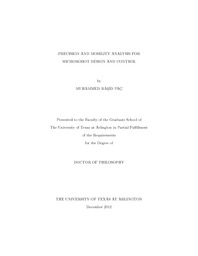
ATTENTION: The works hosted here are being migrated to a new repository that will consolidate resources, improve discoverability, and better show UTA's research impact on the global community. We will update authors as the migration progresses. Please see MavMatrix for more information.
Show simple item record
| dc.contributor.author | Pac, Muhammed Rasid | en_US |
| dc.date.accessioned | 2013-03-20T19:11:54Z | |
| dc.date.available | 2013-03-20T19:11:54Z | |
| dc.date.issued | 2013-03-20 | |
| dc.date.submitted | January 2012 | en_US |
| dc.identifier.other | DISS-11927 | en_US |
| dc.identifier.uri | http://hdl.handle.net/10106/11567 | |
| dc.description.abstract | The emerging field of microrobotics extends from manipulation of nanostructures to 3D assembly of micromachines, and to control of motile bacteria as manipulation tools. Microrobots are not necessarily small themselves but the smallest scale in which they operate is measured in micrometers. Microrobots have to be precise, fast, and flexible to be useful as top-down manufacturing tools. As the relative magnitudes of uncertainties and errors with respect to the operational precision of robots grow towards smaller scales, the requirement for better precision increases. Hence, the concepts of precision analysis and precision-based design are important steps in microrobotic system development. In the case of microrobotic systems involving untethered micro-agents, the primary research focus is on the mobility of the micro-agent and controlling its degrees of freedom. Both of these topics, however, have been insuciently addressed to date although they constitute a decisive consideration towards the ultimate success of the technology.This thesis investigates how to analyze the precision of a microrobot and how to design it based on given precision requirements. Considering the kinematic description of a robot as a mapping between its parameter-space and task-space, we develop a new mathematical formalism for precision analysis and design of robots via interval extension of robot kinematics. An interval is a closed set of numbers represented by its two bounding values. We use intervals to represent uncertain and erroneous parameters in a kinematic description and extend the products of exponentials (POE) formulation to intervals. We define interval functions that take the uncertain POE parameters of a manipulator as input arguments and calculate the forward kinematics map to produce an interval result. We show via theorem-proof pairs, simulations, and experiments that the distribution of the end-effector position due to uncertain kinematic parameters can be bounded using our method. This formulation helps understand the effects of mechanical and sensing errors on the positioning precision of a micromanipulator. Hence, it can be used as a performance evaluation method towards automating a microassembly process. We also propose a new method of precision design of robots by applying our interval POE formulation to the inverse kinematics problem. This provides the bounds on the individual error terms of the parameters such that custom design or configuration of a microrobotic system for a particular end-effector precision requirement can be done. For the microrobotic systems employing a micro-agent as the tool, analysis and control of mobility requires a similar mapping between the parameter-space and the task-space of the micro-agent. To address mobility, we propose a novel power delivery and motion control method based on use of pulsed laser. Simulation and experimental results show that power delivery to a micro-agent is possible with pulsed laser and mobility with multiple degrees of freedom can be achieved. | en_US |
| dc.description.sponsorship | Popa, Dan | en_US |
| dc.language.iso | en | en_US |
| dc.publisher | Electrical Engineering | en_US |
| dc.title | Precision And Mobility Analysis For Microrobot Design And Control | en_US |
| dc.type | Ph.D. | en_US |
| dc.contributor.committeeChair | Popa, Dan | en_US |
| dc.degree.department | Electrical Engineering | en_US |
| dc.degree.discipline | Electrical Engineering | en_US |
| dc.degree.grantor | University of Texas at Arlington | en_US |
| dc.degree.level | doctoral | en_US |
| dc.degree.name | Ph.D. | en_US |
Files in this item
- Name:
- Pac_uta_2502D_11927.pdf
- Size:
- 10.07Mb
- Format:
- PDF
This item appears in the following Collection(s)
Show simple item record


